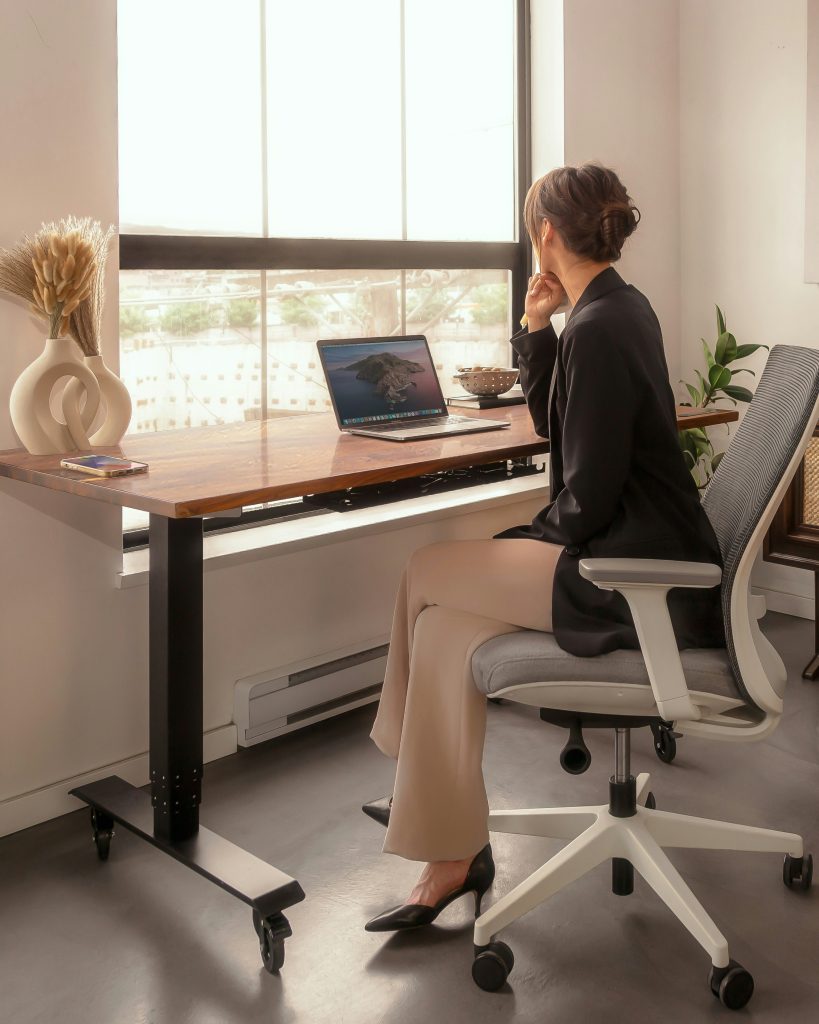Two simple moves that fight poor posture without disrupting your workday
Key Points:
- Pilates expert shares two effective but overlooked exercises that can help office workers combat poor posture from prolonged sitting
- The seated spine twist and chest opener with shoulder blade squeeze can be performed right at your desk without special equipment or changing clothes
- Expert explains how these quick moves can prevent common office-related pain points while strengthening key postural muscles throughout the workday
The average office worker spends approximately 8 hours a day sitting – a position our bodies weren’t designed to maintain for extended periods. This prolonged sitting often leads to rounded shoulders, a hunched upper back, and a weakened core – all contributors to poor posture and potential long-term health issues.
“Many office workers experience discomfort or pain but don’t realise how simple postural adjustments and targeted movements can make a significant difference,” says Sol Scheinmann, Pilates expert and co-founder of Pilates Matters, an online retailer specialising in high-quality Pilates equipment.
Scheinmann has identified two particularly effective yet underused Pilates-based movements that can be easily incorporated into the workday without requiring special equipment, dedicated time blocks, or a change of clothes. These exercises target the specific muscle groups most affected by desk work.
Why Office Workers Need Pilates
Before diving into the exercises, it’s important to understand what happens to your body during prolonged sitting. When you remain seated for hours, your hip flexors tighten, your abdominal muscles disengage, and your chest muscles often contract while your upper back muscles weaken. This creates a physical imbalance that can lead to discomfort and eventually pain.
“Office workers usually focus on general fitness but overlook the specific movements needed to counteract their daily sitting habits,” Scheinmann explains. “These targeted Pilates moves are designed to address exactly what your body needs after hours at a desk.”
Exercise 1: Seated Spine Twist
This simple yet effective exercise improves spinal mobility, reduces stiffness, and directly counteracts the effects of sitting in the same position for extended periods.
How to perform the Seated Spine Twist:
- Sit tall near the edge of your chair with your feet flat on the floor, knees positioned at hip-width apart.
- Engage your core muscles (imagine drawing your navel toward your spine) and place your hands either across your chest or lightly holding the sides of your chair.
- Take a deep breath in to lengthen your spine upward.
- As you exhale, twist your torso to the right, initiating the movement from your ribcage rather than just rotating your shoulders.
- Hold for one full breath while maintaining height through your spine.
- Return to centre on an inhale, then repeat on the left side.
- Perform 5-8 repetitions on each side.
“The key to making this exercise effective is focusing on proper form rather than how far you can twist,” says Scheinmann. “You should feel a gentle rotation through your spine without straining or forcing the movement.”
This exercise is particularly beneficial because it targets spinal mobility in the thoracic (mid-back) region, which tends to become rigid with prolonged sitting. Regular practice helps maintain flexibility in the spine, reduces tension in the lower back, and encourages proper core engagement for better postural support throughout the day.
Exercise 2: Seated Chest Opener with Shoulder Blade Squeeze
This movement directly addresses the forward-hunching posture many office workers develop, opening the chest and strengthening the upper back muscles that support proper alignment.
How to perform the Seated Chest Opener:
- Sit tall at the edge of your chair with feet planted firmly on the ground.
- Interlace your fingers behind your head, keeping your elbows wide.
- Take a deep breath in, and as you exhale, gently press your chest forward while actively squeezing your shoulder blades together.
- Hold this position for 2-3 seconds, feeling both the stretch across your chest and the engagement in your upper back.
- Slowly return to the starting position on an inhale.
- Repeat 5-8 times.
“This exercise works because it simultaneously stretches the tight chest muscles and strengthens the upper back muscles that tend to weaken during long hours of desk work,” Scheinmann notes. “The combination of stretching and strengthening creates better muscular balance, which is essential for good posture.”
Implementation Strategy
Scheinmann recommends incorporating these exercises several times throughout the workday rather than doing them all at once for maximum benefit.
“Set a timer to remind yourself to perform one of these exercises every hour or two,” he suggests. “This approach helps counteract the negative effects of sitting as they occur, rather than trying to undo an entire day’s worth of poor posture at the end of the day.”
Sol Scheinmann, Pilates expert and co-founder of Pilates Matters, commented:
“What makes these two exercises particularly valuable for office workers is their simplicity and effectiveness. Most people think they need to overhaul their routine completely or spend hours at the gym to address posture issues, but these targeted movements can make a significant difference when practiced consistently throughout the workday.
“The seated spine twist and chest opener target the exact muscles that become imbalanced during prolonged sitting. They’re also discreet enough to do at your desk without drawing attention or requiring special equipment. I’ve seen remarkable improvements in clients who have incorporated these movements into their daily work routine, not just in their posture but also in reduced pain and increased energy levels.
“Remember that good posture isn’t about rigid perfection – it’s about creating balance in the body that allows you to move with ease and comfort. These exercises help restore that natural balance that gets disrupted during long hours of desk work.”


